
Soy in the Brazilian Amazon
The success of governments and big corporations in eliminating environmental degradation from the products we consume will play a critical role in determining the fate of the world’s remaining wild places, said a group of experts speaking at a panel during the Skoll World Forum on Social Entrepreneurship [related posts].
Meeting in Oxford last week, the forum included WWF, a major conservation group; Greenpeace, an environmental activist group that is known for colorful campaigns to reform corporate practices; Unilever, a consumer products giant that is one of the world’s largest commodity buyers; UNICA, an association that represents 140 Brazilian sugar cane producers; and Rankbank, the world’s largest agricultural bank, with operations in several key tropical forest countries. The panelists discussed and debated how the world can protect forests in the face of growing demand for agricultural land due to rising population and surging consumption.
“In the 20th century we solved the population problem but in the 21st century we still have to solve the consumption problem,” said Jason Clay, Vice President of Market Transformation at WWF, noting that population growth rates have slowed dramatically since the 1970s and are expected to peak around 2050. “In the next 40 years we need to produce as much food as we produced in the past 8,000.”
“If we don’t get how to produce food and fiber right in next 40 years, we as a conservation group can turn off the lights. There won’t be any biodiversity left to save.”
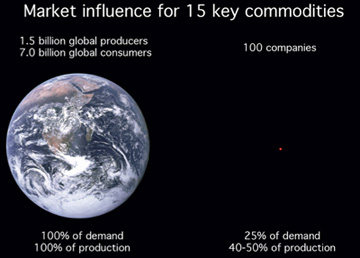
|
Clay said it is therefore critical to make commodity production both more productive and more sustainable, and because big corporations control an increasing share of production and trade, it is essential to target them. Just 300-500 companies worldwide control 70 percent of the trade of each of the 15 key commodities linked to habitat destruction and degradation. And less than 100 corporations impact half of global production.
While WWF generally works to engage these companies by helping “green” their operations, Greenpeace takes a more adversarial approach, staging aggressive campaigns against corporations they believe aren’t doing enough to avoid environmental damage. For example, in 2008 Greenpeace targeted Unilever for its palm oil sourcing, which activists linked to deforestation in Indonesia. Greenpeace’s campaign included issuing a damaging report and sending activists dressed up in orangutan outfits to invade a Unilever shareholders meeting.
Gavin Neath, Senior Vice President for Sustainability at Unilever, was candid about the experience of being targeted by Greenpeace.
“Greenpeace was right to attack us,” he said. “We felt we were being conscientious and were doing more than others but we were not moving nearly fast enough. Greenpeace triggered us into action.”
Unilever would go on to improve its sourcing policy, aiming to eliminate deforestation from its supply chain.
Greenpeace later went after Nestle on palm oil, using a shocking video, which Greenpeace’s Pat Venditti played for the audience. The video and Nestle’s disastrous response to the accompanying social media campaign proved extremely damaging to the food giant. It later established one of the most restrictive policies for sourcing palm oil. The policy was later adopted by its palm oil supplier, Golden Agri Resources / PT Smart, which had been the main target of the Greenpeace campaign.
The threat of a Greenpeace action can be a strong motivator for companies, said Daniela Mariuzzo, Head of Corporate Social Responsibility and Sustainable Business Development of Rabobank-Brazil, which extends credit to farmers and ranchers. Rabobank has used the Greenpeace video internally to demonstrate the potential reputational risk of practices tied to deforestation. The bank is establishing lending policies for 12 sectors it deems “sensitive” for driving deforestation and natural resource depletion, including palm oil in Asia and soy and cattle in Brazil.
Sticks, and carrots
But the panelists agreed that companies shouldn’t only be motivated by “sticks”. They need “carrots” too.
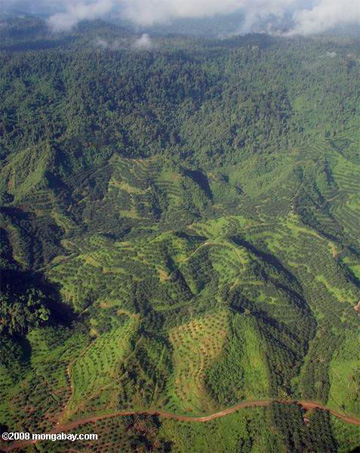 Oil palm plantations and forest in Malaysia |
Macros Jank, CEO of UNICA, said that his industry has gone to great lengths to improve its environmental performance in recent years, including reducing burning, accepting a ban on expansion in the Amazon and Pantanal, and restoring riparian vegetation. But most of the Brazilian sugar cane industry’s buyers aren’t in markets, like Europe, where consumers care about environmental performance of the products they buy.
“Right now we have a surplus of certified products,” he said. “Where’s the demand?”
However, Clay, Venditti, and Neath said that consumer demand has an important, but limited role in driving market transformation.
Noting the difficulties many consumers have in making the “right” choices, Neath said corporations have to do their part to eliminating problems like deforestation from their supply chains.
“Companies have to engineer environmental problems out of consumer choices,” he said.
“Consumers shouldn’t have a choice about sustainability — everything on the shelf should be sustainable,” noted Clay, adding that sustainable products should be cheaper than non-sustainable ones, although today usually the inverse is true.
Factoring in environmental costs could help.
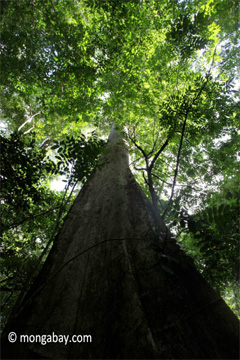 Rainforest tree in Indonesia |
Dan Nepstad, a scientist at the Amazon Environmental Research Institute (INPA) who participated in the discussion, said the world is moving toward standards that incorporate social and environmental externalities into pricing.
“Brazil has achieved a 2 percent reduction in global emissions by cutting deforestation, as much as the Kyoto Protocol, but it wasn’t compensated,” he said. “This is a colossal market failure.”
Andrew Mitchell of the Global Canopy Programme agreed.
“The role of price signals is really important for saving forests,” he said.
Until the costs of environmental damage are priced into commodity production, there is no disincentive to clear forests. Clay said that carbon emissions are a good place to start and suggested that carbon payments could provide incentives for producers to join commodity roundtables, which aim to reduce the environmental footprint of soy, sugar, palm oil, cattle, and biofuel production.
The role of government
Several forum participants agreed however that roundtables focused on sustainability can only move markets so far.
Clay said that certification tends to move just the leaders in a market. The bottom 10-20 percent of the market — which typically accounts for more than half of environmental damage — only responds to government intervention.
“If we do not change the bottom we are just playing on the surface. The way to move the bottom is to get the government involved.”
Panel members suggested that since the market’s willingness to pay a premium for certified products seems limited, governments could reduce import duties on certified agricultural products to level the playing field.
Bioethanol produced from Brazilian sugar cane and certified under the Bonsucro initiative could therefore enter European markets at the same price as sugar cane produced without any social or environmental standards.
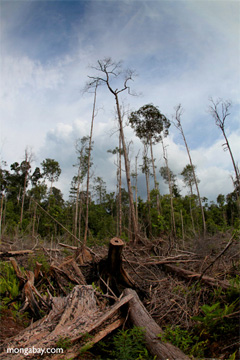 Deforestation in Indonesia |
But to truly transform markets in the long term, governments have to establish legal frameworks, according to Venditti with Greenpeace.
“Certification can be a powerful tool, but it will not be the tool that drives changes,” he noted. “We need to go beyond that to change the political dynamics in forest countries to make this a solution. Educating the consumer is much more about educating voters.”
“If we don’t bring public policy into this, it’s going to be very difficult to bring this to scale.”
Clay added that since just 12 percent of food is traded across international borders, targeting domestic markets — which are moved by government intervention — is critical. And corporations have to work with governments to reform the system.
Venditti agreed that enemies would have to become allies if we hope to solve pressing environmental problems.
“We’re not in the business of transforming companies for the sake of transforming them,” he said. “We’re interested in how transformation reduces deforestation.”
“The question now is whether this will drive sectoral change. We’re looking for transformative change across sectors.”
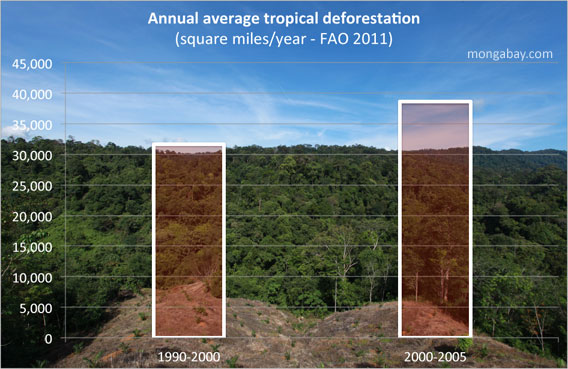
Related articles
Degraded lands hold promise in feeding 9 billion, while preserving forests
(03/29/2012) Making productive use of degraded lands and boosting productivity of small-holder farmers are key to meeting surging global consumption of agricultural products while preserving critical wildlife habitats, said an agricultural expert on the sidelines of the Skoll World Forum for Social Entrepreneurship in Oxford.
Corporations, conservation, and the green movement
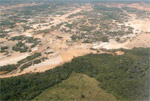
(10/21/2010) The image of rainforests being torn down by giant bulldozers, felled by chainsaw-wielding loggers, and torched by large-scale developers has never been more poignant. Corporations have today replaced small-scale farmers as the prime drivers of deforestation, a shift that has critical implications for conservation. Until recently deforestation has been driven mostly by poverty—poor people in developing countries clearing forests or depleting other natural resources as they struggle to feed their families. Government policies in the ’60s, ’70s, and ’80s had a multiplier effect, subsidizing agricultural expansion through low-interest loans, infrastructure projects, and ambitious colonization schemes, especially in the Amazon and Indonesia. But over the past two decades, this has changed in many countries due to rural depopulation, a decline in state-sponsored development projects, the rise of globalized financial markets, and a worldwide commodity boom. Deforestation, overfishing, and other forms of environmental degradation are now primarily the result of corporations feeding demand from international consumers. While industrial actors exploit resources more efficiently and cause widespread environmental damage, they also are more sensitive to pressure from consumers and environmental groups. Thus in recent years, it has become easier—and more ethical—for green groups to go after corporations than after poor farmers.
How Greenpeace changes big business

(07/22/2010) Tropical deforestation claimed roughly 13 million hectares of forest per year during the first half of this decade, about the same rate of loss as the 1990s. But while the overall numbers have remained relatively constant, they mask a transition of great significance: a shift from poverty-driven to industry-driven deforestation and geographic consolidation of where deforestation occurs. These changes have important implications for efforts to protect the world’s remaining tropical forests in that environmental groups now have identifiable targets that may be more responsive to pressure on environmental concerns than tens of millions of impoverished rural farmers. In other words, activists have more leverage than ever to impact corporate behavior as it relates to deforestation. A prime example of this power is evident in a string of successful Greenpeace campaigns, which have targeted some of the largest drivers of deforestation, including the palm oil industry in Indonesia and Malaysia and the soy and cattle industries in the Brazilian Amazon. The campaigns have shared a common approach: target large, conspicuous consumer-facing companies that sell in western markets.
New strategies for conserving tropical forests [PDF]
(06/22/2008) In an interval of just 1–2 decades, the nature of tropical forest destruction has changed. Rather than being dominated by rural farmers, tropical deforestation now is substantially driven by major industries and economic globalization, with timber operations, oil and gas development, large-scale farming and exotic-tree plantations being the most frequent causes of forest loss. Although instigating serious challenges, such changes are also creating important new opportunities for forest conservation. Here we argue that, by increasingly targeting strategic corporations and trade groups with public pressure campaigns, conservation interests could have a much stronger influence on the fate of tropical forests.














